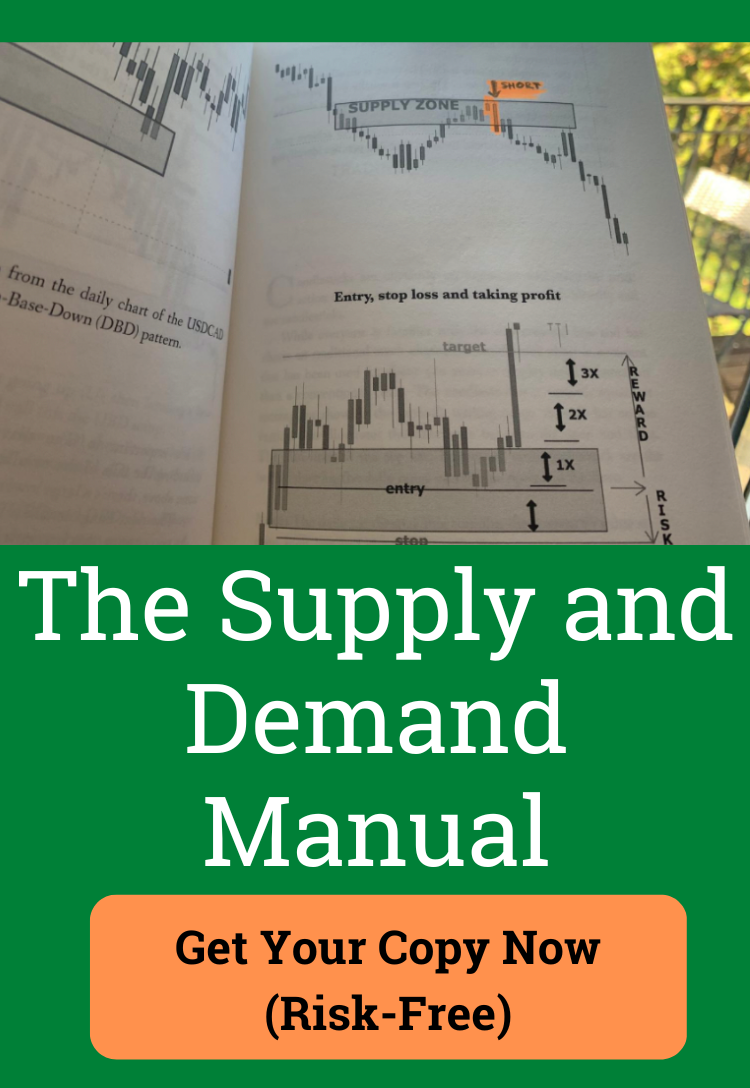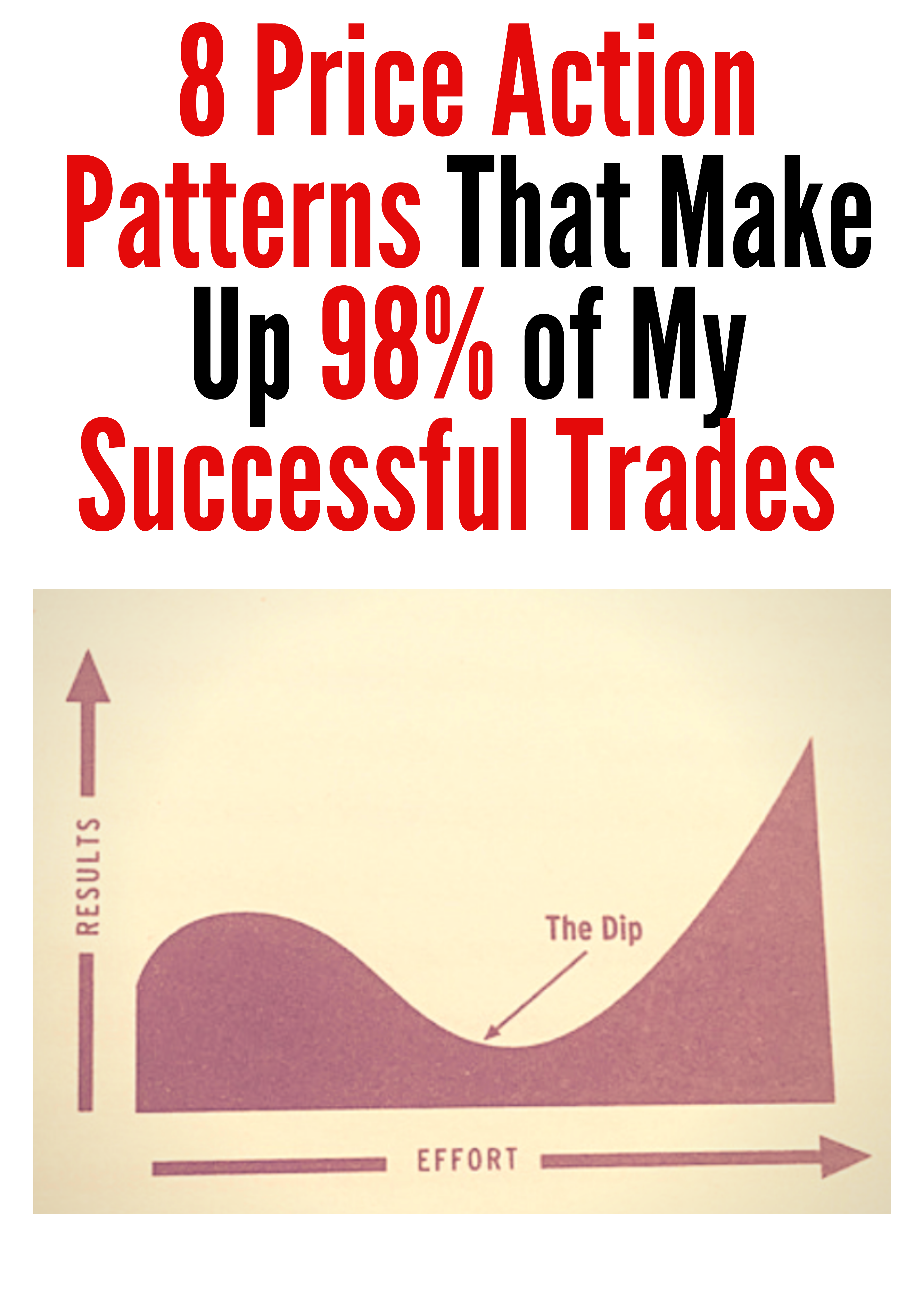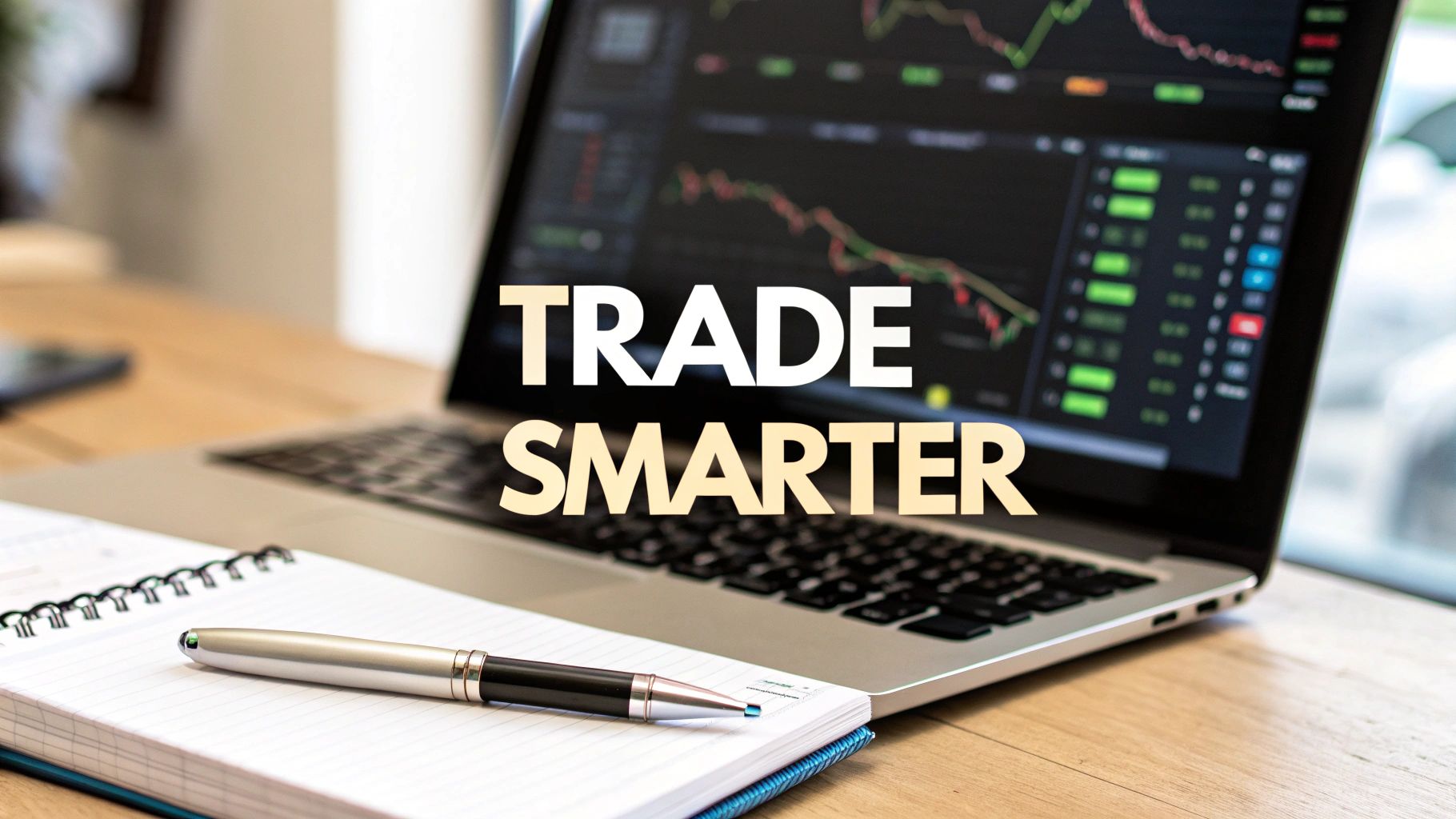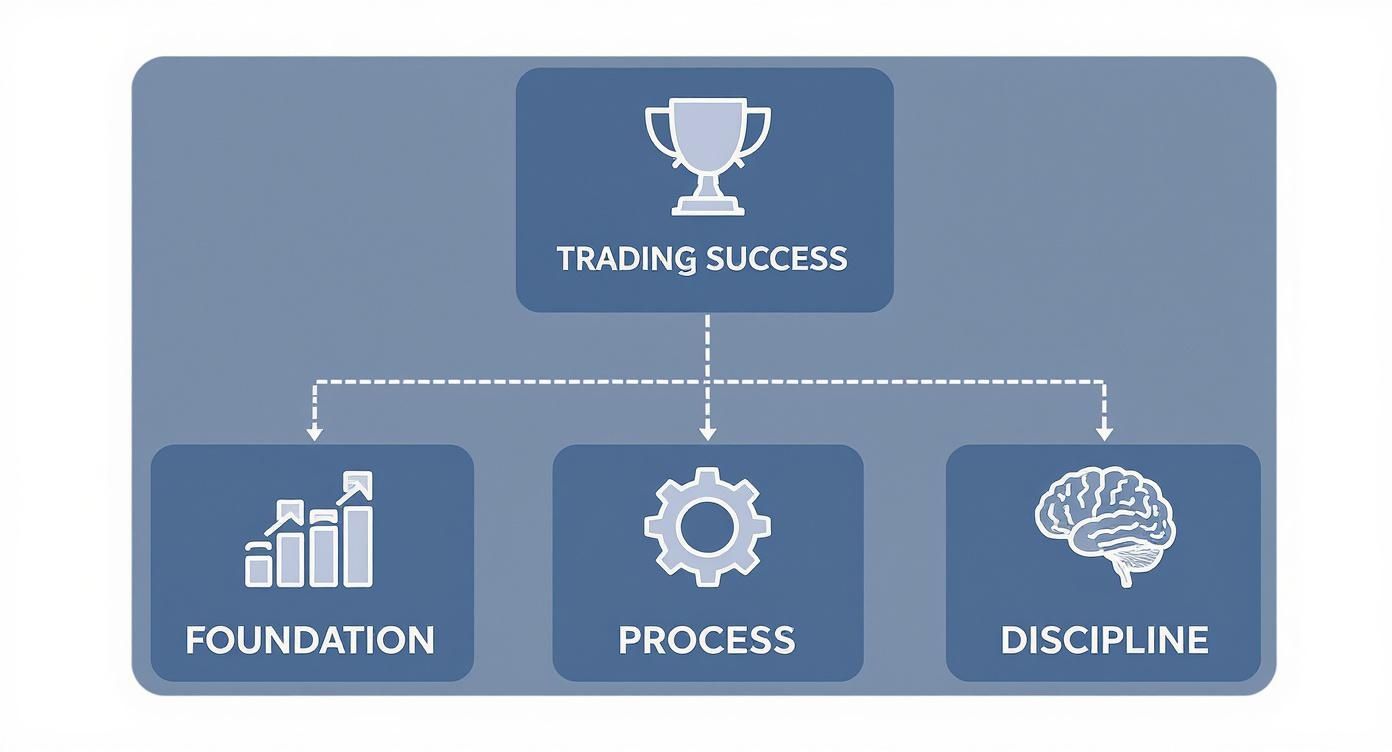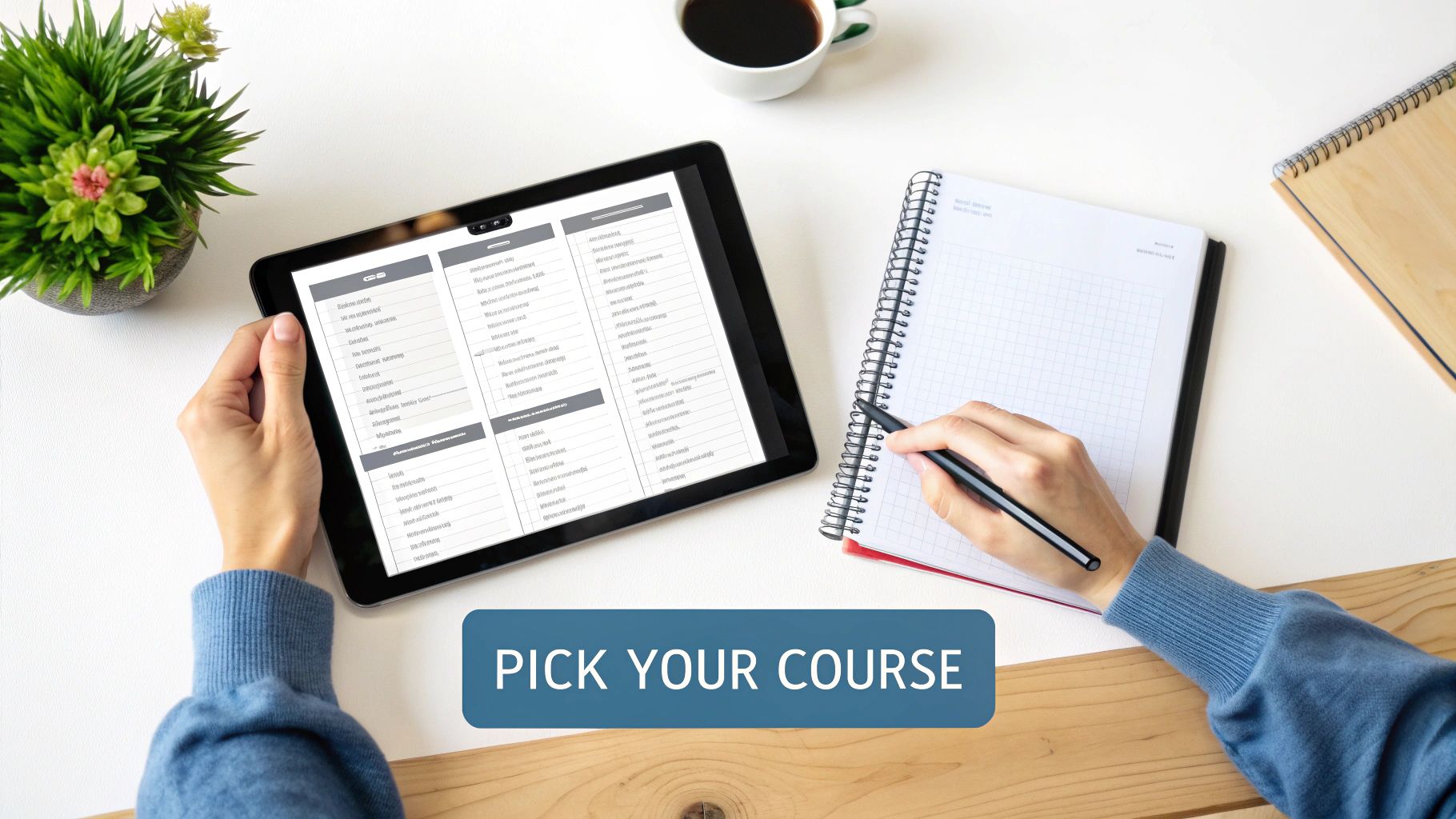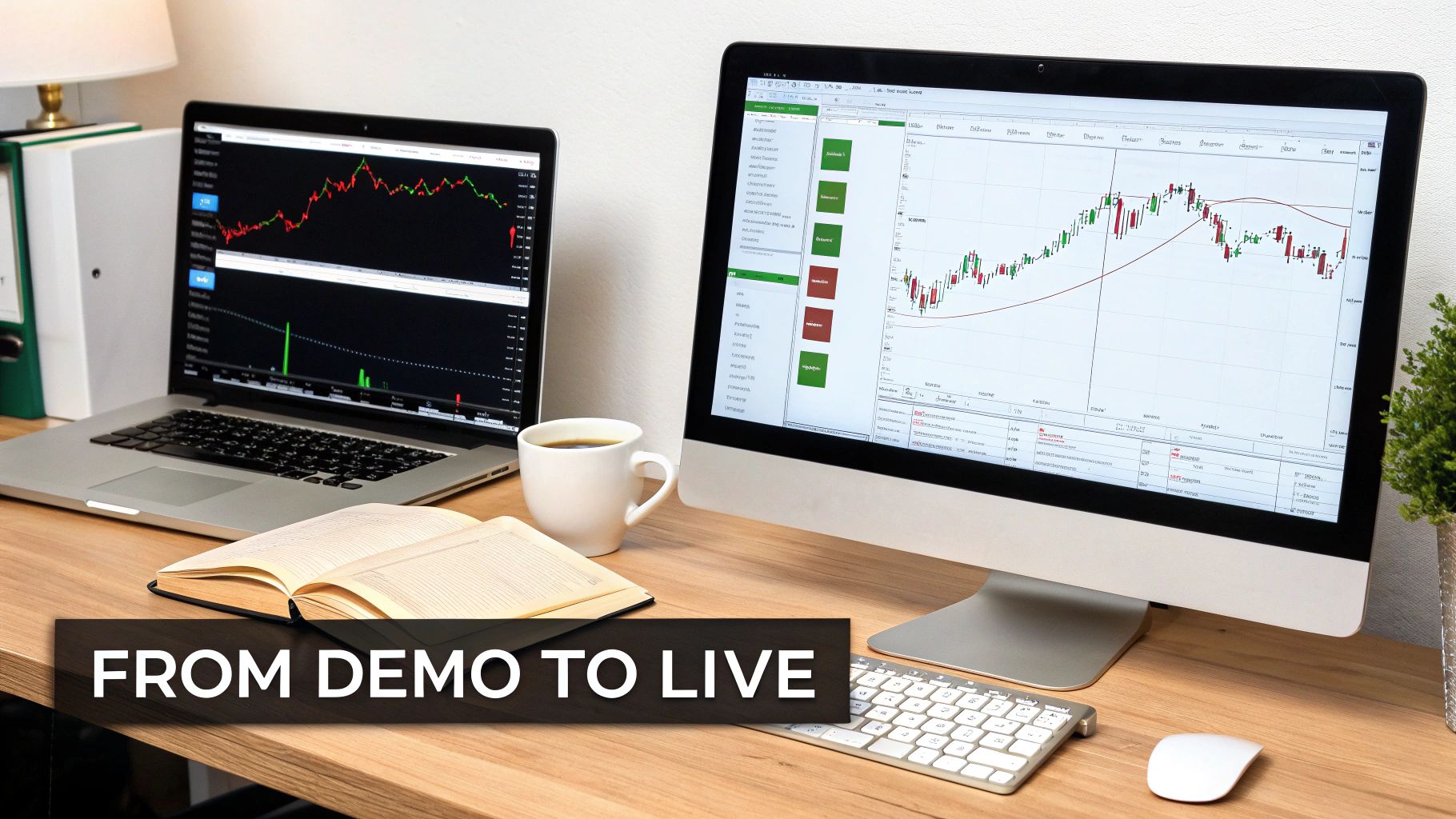forex trading courses online: Learn to Trade Smarter
The best forex trading courses online give you a structured, expert-led roadmap for building your skills from the ground up. This is a world away from the random, disconnected tips you find scattered across the internet. A good course offers a systematic path to understanding how the market really works, managing your risk, and developing a solid strategy.
Why a Trading Course Is Your First Smart Investment
Jumping into the forex market without any real training is like a pilot trying to fly a 747 after watching a few YouTube videos. The dashboard looks confusing, the risks are huge, and a costly mistake is pretty much guaranteed. Think of a structured course as your flight school—it teaches you how to handle turbulence, read the instruments, and land safely.
The point isn't just to memorize definitions for "pips" and "lots." The real goal is to build a repeatable, disciplined process for analyzing the market and placing trades. Without this foundation, it’s all too easy to get caught up in emotional decisions, chasing quick profits and throwing risk management out the window. A systematic learning path is what separates consistent traders from those who quickly burn through their accounts.
Building a Foundation Beyond Random Tips
Sure, the internet is flooded with free trading information, but it’s a chaotic mess with no quality control. A well-designed online course cuts through that noise and organizes everything into a logical progression. You start with the fundamentals and slowly build up to more complex strategies, making sure you don't miss any critical steps along the way.
A formal course provides what fragmented online content cannot: a cohesive framework. It connects the dots between chart analysis, trading psychology, and money management, creating a holistic skill set instead of a collection of disconnected tactics.
This structured approach is crucial, especially for beginners. Recent data shows that around 72% of all forex traders start with zero prior trading experience. It’s also telling that about 53% of traders invested in educational resources like courses or books last year, a clear sign they’re looking for an edge. You can dig into more of these insightful forex trading statistics at BestBrokers.com. This tells us that serious traders know they need a solid educational foundation.
From Theory to Practical Application
The real value of a great course is how it bridges the gap between knowing something and actually doing it. It gives you the necessary tools—like understanding the MetaTrader 4 platform, which is used by 85% of traders—and teaches you how to use them effectively. The best programs guide you from understanding a concept to applying it in a safe, risk-free environment, like a demo account.
Ultimately, investing in a course is an investment in your own decision-making. It gives you a process for spotting opportunities and managing risk, which are the cornerstones of long-term success in this game. To really see the payoff, it's smart to understand how to measure training effectiveness and ROI. This ensures your investment in a forex course leads to tangible results. Your first smart move isn't a trade; it's the education that prepares you for all the trades that follow.
Anatomy of a High-Impact Forex Trading Course
So, what separates a world-class educational experience from just another information dump? The best forex trading courses online aren't just a playlist of videos; they’re meticulously structured journeys designed to build your skills from the ground up. Think of it like learning to build a house—you can't start with the roof and hope the walls will hold up later.
A truly great course begins with the foundation: market fundamentals. This is where you get fluent in the language of forex—pips, lots, leverage, and currency pairs. Without this solid base, nothing else you learn will make any sense. Once that's poured and set, the course starts framing the walls, which is your core understanding of technical analysis. Here, you’ll learn how to actually read charts, spot emerging trends, and interpret the price action that drives every market move.
Building Beyond the Basics
With the core structure in place, it’s time to install the critical systems. The plumbing and electrical work of your trading house represents risk management and trading psychology. This is the stuff that keeps everything running smoothly. This module teaches you how to protect your capital and keep your emotions in check—the two things that trip up over 90% of aspiring traders. The goal isn't to win every single trade; it's to survive the inevitable losses so you can stay in the game long enough to be profitable.
Finally, the course helps you put the finishing touches on your new build. This last phase is all about building and backtesting your personal trading strategy. It pulls everything together—fundamentals, analysis, and risk control—into a cohesive plan that actually fits your personality and financial goals. This step-by-step progression is the hallmark of a program built for real-world results, not just theoretical knowledge. If you're curious about what goes into creating these effective learning paths, it helps to see how experts master online course design to keep students engaged and successful.
This infographic breaks down the essential pillars that support long-term trading success.
As you can see, a solid foundation, a repeatable process, and unwavering discipline are the non-negotiables for reaching your goals as a trader.
The Essential Course Curriculum
When you're comparing different courses, you need to look for a curriculum that covers these critical areas in a logical, step-by-step order. A well-designed program will guide you through each stage, making sure you’ve got one concept down cold before you move on to the next.
Here's a look at what the most effective forex course curriculums include.
Essential Modules in a Forex Trading Course Curriculum
| Module Category | Key Topics Covered | Why It's Important |
|---|---|---|
| Market Fundamentals | The basics: how the forex market works, key terminology (pips, lots, leverage), and how to navigate a trading platform. | This is your foundation. Without it, the more advanced concepts won't make sense, and you'll be lost from the start. |
| Technical Analysis | In-depth lessons on chart patterns, candlestick analysis, key indicators, and, most importantly, price action. | This is how you learn to "read" the market's story directly from the charts, enabling you to spot potential opportunities. |
| Risk & Money Management | The crucial skills: calculating position sizes, setting proper stop-losses, and defining your risk-to-reward ratio. | This is what keeps you in the game. Poor risk management is the #1 reason traders blow up their accounts. |
| Trading Psychology | How to handle the emotional rollercoaster of fear, greed, and impatience. Developing a trader's mindset. | Your mindset is half the battle. A winning strategy is useless if your emotions lead you to break your own rules. |
| Strategy Development | Tying it all together to create a personalized trading plan with clear entry/exit rules and a performance tracking method. | This is where you build your own system. It transforms you from someone following signals to a self-sufficient trader. |
This structured approach is what ensures you build a complete and robust skill set.
If you want to go deeper into one of the most powerful trading methods out there, you might find our guide on the best price action trading courses really helpful.
The goal of a high-impact course isn't to give you a "secret" strategy that never fails. Instead, it's to equip you with a robust framework for making your own informed, disciplined, and confident trading decisions, day in and day out.
This is what transforms you from a passive student into an active, thinking trader. A comprehensive curriculum gives you the tools and the process you need to navigate the forex market with skill, setting you on a path toward consistency.
How to Choose a Course That Fits Your Trading Goals
The world of forex trading courses online is absolutely flooded. Trying to sort the good from the bad can feel like a full-time job in itself. But picking the right program isn't about uncovering some "secret sauce"; it's about finding the right guide for your journey.
Think of it like hiring a personal trainer. You wouldn't just sign up with the first person you meet at the gym. You'd check their credentials, see what kind of results their clients are getting, and make sure their coaching style actually clicks with you. That's the exact mindset you need here.
The whole point is to find a program that lines up with your learning style, budget, and where you want to be as a trader in the long run. Get this right, and you'll sidestep the noise and invest in an education that truly moves the needle.
Evaluate the Instructor and Their Experience
This is, without a doubt, the most important piece of the puzzle. Who is teaching the course? Is it a proven, practicing trader with a track record you can actually verify, or just a slick marketer? Anyone can talk a good game, but a great instructor shows their work.
Look for educators who are in the trenches, trading the very strategies they teach, and who are transparent about their process. If all you see are flashy lifestyles and luxury cars but no real-time analysis or trade breakdowns, be wary. The best mentors are focused on teaching a repeatable process, not just selling a dream.
- Look For: Instructors who actively trade and share their analysis.
- Avoid: Marketers who are more focused on selling a lifestyle than on explaining chart setups.
Assess the Course Delivery and Learning Style
How do you learn best? This is a critical question. Some people absolutely thrive in live, interactive sessions where they can fire off questions as they come up. Others need the flexibility of on-demand videos they can pause, rewind, and re-watch on their own schedule.
The format of a course directly impacts how well you absorb its content. The choice between live sessions and pre-recorded modules is a key decision point, and one isn't inherently better than the other—it's about what works for you.
This decision often comes down to your personal schedule and learning preferences. For a deeper look at the pros and cons, our article comparing online learning vs traditional classroom settings offers some valuable insights. Whatever the format, make sure the content is structured logically. It should build from the ground up, moving from fundamental concepts to more advanced applications without jumping all over the place.
Investigate the Community and Support System
Let's be honest: trading can be a lonely road. That’s why a strong community isn’t just a nice-to-have; it's an invaluable asset. Does the course offer a dedicated forum, a Discord server, or a private group for students? This is where the real learning often happens. It's a place to ask questions, share trade ideas, and get support during those inevitable rough patches.
A good community provides accountability and keeps you motivated. It turns learning from a solo chore into a collaborative journey. Look for programs where the instructor is actually present and active in the community, answering questions and providing ongoing mentorship. That kind of involvement shows a genuine commitment to your success long after they've made the sale.
Red Flags to Watch Out For
Finally, knowing what to avoid is just as important as knowing what to look for. A few clear warning signs can help you steer clear of the junk.
- Guarantees of Profit: This is the biggest red flag of them all. Period. No one can guarantee profits in the financial markets. Trading involves risk, and any course promising you a sure thing is being flat-out dishonest.
- Overemphasis on "Secret" Indicators: Successful trading is built on a solid foundation of price action and risk management. It’s not about some magical, proprietary indicator that claims to predict every market move.
- Lack of Transparency: If you can't find clear information about the instructor, the curriculum, or what you're actually paying for, walk away. Reputable educators are open about their methods and what their course delivers.
By carefully vetting the instructor, the course structure, and the community support—while keeping an eye out for these red flags—you can confidently pick one of the many forex trading courses online that will genuinely help you grow as a trader.
Translating Classroom Knowledge into Real Trades
Theory is just the blueprint; real trading is building the house. The best forex trading courses online get this. They focus intensely on bridging that gap between learning a concept and actually applying it under pressure. This is where abstract knowledge gets forged into a tangible, repeatable skill.
Think of it like learning to play the piano. You can memorize scales and study music theory for months, but until you sit down and actually press the keys, you can't create music. Top-tier courses provide the "piano"—the practical tools and environments that let you turn lessons into real-world trading decisions.
This transition from student to practitioner is the single most critical phase of your development. It’s where you prove to yourself that the strategies work and build the rock-solid confidence you need to manage real capital.
The Power of Risk-Free Practice
The first, and most essential, tool for any new trader is the demo account. You'll also hear it called a practice or simulated account. This is your training ground—a live market simulator where you can execute trades with virtual money. It's the perfect place to apply the chart patterns and strategies you’ve learned without risking a single dollar of your own.
Imagine a new pilot practicing landings in a state-of-the-art flight simulator before ever touching a real aircraft. A demo account serves the exact same purpose. You can test your entry and exit points, practice your risk management rules, and get comfortable with your trading platform's mechanics in a completely safe environment. If this is a new concept, our detailed guide explains more about what paper trading is and how it works.
This isn't just about playing a game; it's about building muscle memory and discipline. You follow the same process you would with live funds, reinforcing good habits until they become second nature.
Live Trading Rooms and Real-Time Mentorship
While demo accounts are crucial for individual practice, live trading rooms take things to the next level. These are sessions where you can watch an experienced instructor analyze the market and execute trades in real-time. It’s like having a master craftsman narrate their every move while working on a project.
In a live trading room, you see how a professional trader identifies setups from the course material, manages risk when a trade moves against them, and maintains discipline under live market conditions. This experience is invaluable for connecting theory to dynamic, real-world execution.
This live mentorship helps you see the "why" behind every decision. You get to witness how a seasoned trader reacts to unexpected news or a sudden spike in volatility, learning how to adapt your strategy on the fly. This kind of practical exposure can accelerate your learning curve immensely compared to just studying static chart examples on your own.
From Simulation to Execution: A Trader's Journey
So, how does this all come together for a typical student? Let's walk through it with a trader we'll call Alex, who just learned about the classic "head and shoulders" reversal pattern in their course.
- Spot the Pattern: While monitoring the EUR/USD chart, Alex identifies what looks like a classic head and shoulders formation—a potential signal that the uptrend is running out of steam.
- Test in the Simulator: Instead of immediately jumping in with real money, Alex opens their demo account. They place a short trade according to the rules taught in the course, setting a precise stop-loss above the right shoulder and a take-profit target based on the pattern's height.
- Validate and Refine: The simulated trade plays out successfully. Alex repeats this process over several weeks, testing the pattern on different currency pairs and timeframes. They're building a statistical track record that proves the strategy's validity.
- Execute with Confidence: With a solid process and proven results from the demo account, Alex is now ready to execute a similar trade with a small amount of real capital, fully confident in their strategy and risk management plan.
This structured progression—learn, test, execute—is what separates disciplined traders from gamblers. The global online forex education sector has grown precisely because it offers this kind of pathway. A program like The Forex Trading Coach, which has been running since 2009, has guided thousands of traders using these exact methods, with many reporting significant account growth. It just goes to show how structured education gives you a clear process for making confident trading decisions, rather than just relying on guesswork.
The Future of Forex Education and Trading
The forex market moves fast. The way we learn to trade it needs to keep up. Gone are the days of static PDF guides and watching a few outdated videos. The best forex trading courses online today are living, breathing ecosystems designed to get you ready for the market of tomorrow, not the one from last year.
This whole shift is being pushed forward by some powerful new tech and a completely different way traders are connecting with each other. If you're picking a course, you need to understand these trends. It’s like the difference between learning to navigate with an old paper map versus firing up a live GPS.
The Rise of AI and Algorithmic Tools
One of the biggest game-changers is how artificial intelligence and algorithmic tools are becoming part of the everyday trader's toolkit. Don't worry, this doesn't mean you need to become a coding genius overnight. It just means the top-tier courses are now teaching you how to use tools that make your market analysis a whole lot smarter.
Think of AI-driven analytics as your own personal, highly-skilled research assistant. It can tear through mountains of data to spot patterns or flag shifts in market sentiment—stuff that would take you hours to do by yourself. For a student, this means you’re learning to use smarter tools that can double-check your own analysis and help you build a much stronger trading strategy.
And it's not just AI. Algorithmic trading isn’t just for the big hedge funds anymore. A lot of modern courses now walk you through the basics of automated systems. They teach you how to build or use simple trading bots (often called Expert Advisors) that can execute your strategy 24/7. This gets you away from the screen and, maybe more importantly, takes the emotion out of your decisions by sticking to the plan.
Community-Based Learning and Mobile-First Trading
Another huge change is the move away from learning in a silo. We're now seeing interactive, community-based models taking over. Platforms like Discord and private forums have basically become virtual trading floors. Students can share charts, ask questions, and get instant feedback from instructors and other traders. This kind of collaborative space really speeds up the learning curve and gives you a support network.
The modern trading course is no longer just a one-way lecture. It’s a living community where traders grow together, holding each other accountable and sharing the journey's highs and lows.
This community element goes hand-in-hand with the massive trend toward mobile-first trading. More and more traders are running their entire operation straight from their smartphones. Any course worth its salt has to teach the specifics of mobile charting, execution, and managing your risk on a smaller screen.
You can see these shifts in the numbers. The retail trading world has grown by about 15% in the last five years, mostly because it's so easy to get started on a phone and because of social media. The younger crowd, traders under 25, make up 10% of the market and are almost entirely mobile-focused. At the same time, the biggest group of traders, those aged 35-44 (28% of the market), are using more strategic and automated tools to fit trading around their careers. You can dive deeper into these demographic shifts in forex trading on seacrestmarkets.io.
By getting a handle on these trends, you can pick a course that doesn't just teach you timeless price action principles but also gets you comfortable with the tools and platforms that are defining the future of trading.
Your Action Plan for Confident Trading
Finishing one of the best forex trading courses online is a fantastic achievement. But think of it as the starting line, not the finish. The real work starts now, turning what you've learned in the classroom into disciplined, real-world action.
This is your roadmap to get you from theory to practice. We'll walk through making the jump from a demo account to the live markets, why your education never really stops, and how a good community can keep you grounded. This is how you start building real, lasting confidence.
From Demo to Live Trading
The first move is a careful, measured step from your demo account to a live one. Don't rush this. Your goal is to prove your strategy actually works in a simulated environment before any real money is on the line. Once you’ve strung together consistent results for a few weeks or months, you’re ready.
Start small. Seriously small. Your first live trades should use a position size that feels almost meaningless from a profit and loss standpoint. This takes the emotional heat off and lets you focus completely on one thing: executing your plan flawlessly.
The point of your first live trades isn't to get rich quick; it's to prove you can stick to your rules when real money is involved. Think of your first live account as the final exam of your trading education.
Journaling and Continuous Learning
Here's a secret: your trading education is never over. The market is a living, breathing thing that's always changing, and you have to change with it. The single best tool for this constant improvement is a trading journal.
Write down every single trade. Log the setup, why you entered, what happened, and—just as important—how you felt while it was all going down. This simple habit turns every trade, whether it's a winner or a loser, into a priceless lesson.
- Review your journal every week. Hunt for patterns. What are you doing right? More importantly, what mistakes keep popping up?
- Stay hungry. Keep reading, follow analysts you trust, and go back through your course materials.
- Tweak, don't overhaul. Use what you learn from your journal to make small, intelligent adjustments to your trading plan over time.
This commitment to brutal self-honesty is what separates the pros from the amateurs.
Finding Your Trading Tribe
Finally, never underestimate the power of a good community. Trading can feel like a lonely game, but you don't have to fly solo. Get active in the community that came with your course or find other reputable forums and groups.
Sharing your ideas and seeing how other disciplined traders approach the market gives you fresh perspectives and keeps you accountable. A solid network is there to offer a bit of encouragement when you're in a drawdown and to celebrate the wins with you, keeping you motivated for the long haul.
Your Questions About Forex Courses, Answered
Jumping into the world of forex trading courses online can feel like stepping into the unknown. You've probably got a dozen questions buzzing around, and you need real, straight-to-the-point answers before you commit your time and hard-earned cash. This section is all about cutting through the hype and giving you that clarity.
We're going to tackle the big questions head-on—from whether paid courses are even worth it to how long it really takes to get good at this. My goal here is to help you set the right expectations from day one.
Do I Really Need a Paid Course to Learn Forex?
This is the big one, isn't it? With a sea of free information on YouTube and Google, it’s a fair question to ask. But here's the thing: that free information is a jumbled, often contradictory, mess. It’s like trying to build a house with a pile of lumber and no blueprint.
A solid, paid course is your blueprint. It’s an investment in a structured, logical roadmap created by someone who's already walked the path. You're not just paying for information; you're paying for a proven process, structure, and accountability. This can be the difference between months of frustration and making real, steady progress.
How Long Does It Take to Become a Profitable Trader?
There’s no magic number here. If any course promises you’ll be making bank in 30 days, you should run in the other direction. Your timeline depends completely on you—your dedication, your discipline, and how much time you put into practice.
Generally, the journey breaks down like this:
- Foundational Learning (1-3 Months): This is when you're absorbing the core material from your course. Think technical analysis, risk management, and the nuts and bolts of your strategy.
- Demo Trading (3-6+ Months): Now you're in the simulator. This is where you apply everything you've learned in a risk-free space, hammering out the kinks in your strategy and building consistency. Don't rush this step.
- Live Trading (Ongoing): Once you've proven you can be consistently profitable in a demo account, you're ready to trade with a small live account. But the learning never, ever stops.
Becoming a consistently profitable trader is a marathon, not a sprint. Focus on mastering the process and building rock-solid habits. Profitability is the natural byproduct of that hard work.
Are Forex Courses a Scam?
Let's be honest: the industry has its fair share of snake oil salesmen. But there are also plenty of legitimate, high-value forex trading courses online. The trick is learning how to spot the difference.
Reputable courses are all about teaching you a skill set. They focus on risk management, strategy development, and the psychology of trading. They empower you to make good decisions. Scams, on the other hand, promise the world. They flash guaranteed high returns, sell "secret" indicators, and obsess over a flashy lifestyle instead of actual, practical education. Always do your homework, look for genuine student testimonials, and stick with educators who are transparent about both the rewards and the very real risks of trading.
What Is a Realistic Budget for a Good Course?
You'll see courses priced from a few hundred dollars to several thousand. A bigger price tag doesn't automatically mean a better course. Instead of fixating on the price, look at the value you're getting for your money.
A great course should offer:
- A complete, well-organized curriculum.
- Access to an active community of fellow traders.
- Some form of ongoing support or mentorship from the instructor.
Often, a mid-range course from a respected, active trader hits that sweet spot of quality and affordability. Remember, your education is the single most important tool in your trading arsenal. Choose a program that gives you actionable skills that will pay for themselves for years to come.
Ready to stop guessing and start learning a proven, indicator-free approach to the markets? At Colibri Trader, we provide the no-nonsense, price-action education you need to build confidence and consistency. Find out if you have what it takes with our free Trading Potential Quiz today!


